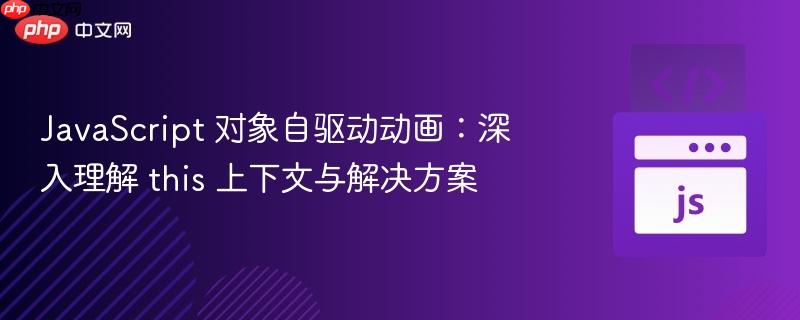
本文深入探讨在javascript中创建可自我动画的对象时遇到的`this`上下文问题。当对象方法作为`settimeout`回调函数使用时,`this`的指向会意外变为全局`window`对象,导致动画逻辑失效。教程提供了两种核心解决方案:使用es6箭头函数实现词法作用域的`this`,以及利用`function.prototype.bind()`方法显式绑定`this`。文章包含详细代码示例,旨在帮助开发者构建结构清晰、行为独立的动画组件。
在JavaScript中,我们经常需要创建能够独立执行特定行为的对象,例如在Canvas上移动的图形。理想情况下,这些对象的动画逻辑应该封装在其自身的方法中,实现“自驱动”的效果。然而,当这些方法涉及到定时器(如setTimeout或setInterval)作为回调函数时,一个常见的陷阱是this上下文的丢失,导致动画无法按预期执行。
考虑以下场景:我们希望创建一个SelfMovingBox对象,它有一个animate方法,该方法负责更新盒子位置并在一段时间后再次调用自身,从而形成动画循环。
<canvas id="diagramCanvas" width="600" height="200" style="border:1px solid #000;"></canvas>
<script>
const Canvas = document.getElementById("diagramCanvas");
const CanvasContext = Canvas.getContext('2d');
const width = Canvas.width, height = Canvas.height;
function SelfMovingBox() {
this.x = width; // 初始位置在Canvas右侧
this.y = 10;
this.boxWidth = 100;
this.boxHeight = 20;
this.speed = 10;
this.draw = function() {
CanvasContext.save();
CanvasContext.strokeStyle = 'blue';
CanvasContext.strokeRect(this.x, this.y, this.boxWidth, this.boxHeight);
CanvasContext.restore();
};
this.clear = function() {
// 清除当前盒子占据的区域
CanvasContext.clearRect(this.x - this.speed, this.y, this.boxWidth + this.speed, this.boxHeight);
};
this.animate = function() {
// 第一次调用时,this 指向 SelfMovingBox 实例
// 但在 setTimeout 回调中,this 将指向 Window 对象
this.clear(); // 尝试清除上一帧
this.x -= this.speed; // 尝试更新位置
this.draw(); // 尝试绘制新位置
if (this.x + this.boxWidth > 0) { // 如果盒子还在Canvas内
setTimeout(this.animate, 100); // 再次调用 animate 方法
}
};
}
let box = new SelfMovingBox();
box.animate();
</script>上述代码尝试创建一个向左移动的蓝色方块。然而,当animate方法通过setTimeout(this.animate, 100)被调用时,this的上下文会从SelfMovingBox实例变为全局的Window对象(在严格模式下为undefined)。这意味着在setTimeout内部,this.clear()、this.x和this.draw()等操作将无法访问到SelfMovingBox实例的属性和方法,导致动画失效,甚至可能引发错误(如尝试在Window对象上调用clear方法)。
ES6 箭头函数提供了一种简洁的方式来解决this上下文问题。箭头函数没有自己的this绑定,它会捕获其所在上下文的this值,并将其作为自己的this。这被称为“词法作用域的this”。
立即学习“Java免费学习笔记(深入)”;
将animate方法定义为一个箭头函数,或者在setTimeout的回调中使用箭头函数,可以确保this始终指向SelfMovingBox实例。
function SelfMovingBox() {
this.x = width;
this.y = 10;
this.boxWidth = 100;
this.boxHeight = 20;
this.speed = 10;
this.draw = function() { /* ... 同上 ... */ };
this.clear = function() { /* ... 同上 ... */ };
// 使用箭头函数定义 animate 方法
this.animate = () => {
this.clear();
this.x -= this.speed;
this.draw();
if (this.x + this.boxWidth > 0) {
// 在箭头函数内部,this 始终指向 SelfMovingBox 实例
setTimeout(this.animate, 100);
} else {
// 动画结束时清除画布
this.clear();
}
};
}
// ... (后续创建实例和调用 animate 同上) ...function SelfMovingBox() {
this.x = width;
this.y = 10;
this.boxWidth = 100;
this.boxHeight = 20;
this.speed = 10;
this.draw = function() { /* ... 同上 ... */ };
this.clear = function() { /* ... 同上 ... */ };
this.animate = function() {
this.clear();
this.x -= this.speed;
this.draw();
if (this.x + this.boxWidth > 0) {
// 使用箭头函数作为 setTimeout 的回调
// 此时箭头函数会捕获外部 animate 函数的 this (即 SelfMovingBox 实例)
setTimeout(() => this.animate(), 100);
} else {
this.clear();
}
};
}
// ... (后续创建实例和调用 animate 同上) ...这两种箭头函数的使用方式都能有效解决this的指向问题。第一种方式更简洁,直接将方法定义为箭头函数;第二种方式则在回调处按需绑定。
Function.prototype.bind()方法允许我们创建一个新的函数,该函数在被调用时,将其this关键字设置为提供的值。这提供了一种显式绑定this上下文的方式。
我们可以预先将animate方法绑定到SelfMovingBox实例上,这样无论它如何被调用,this都将指向该实例。
function SelfMovingBox() {
this.x = width;
this.y = 10;
this.boxWidth = 100;
this.boxHeight = 20;
this.speed = 10;
this.draw = function() { /* ... 同上 ... */ };
this.clear = function() { /* ... 同上 ... */ };
// 定义原始的 animate 方法
let _animate = function() {
this.clear();
this.x -= this.speed;
this.draw();
if (this.x + this.boxWidth > 0) {
// 调用已经绑定了 this 的 animate 方法
setTimeout(this.animate, 100);
} else {
this.clear();
}
};
// 使用 bind 方法将 _animate 绑定到当前实例 (this),并赋值给 this.animate
this.animate = _animate.bind(this);
}
// ... (后续创建实例和调用 animate 同上) ...在这个示例中,_animate.bind(this)创建了一个新的函数,其中this永久地指向SelfMovingBox实例。当setTimeout(this.animate, 100)被调用时,即使setTimeout会改变回调的this,它接收到的this.animate已经是一个预绑定了正确上下文的函数,因此问题得到解决。
结合上述解决方案,以下是一个使用箭头函数实现自驱动动画的完整示例,包括Canvas的设置和动画的停止条件:
<!DOCTYPE html>
<html lang="zh-CN">
<head>
<meta charset="UTF-8">
<title>JavaScript 自驱动对象动画</title>
<style>
body { margin: 20px; font-family: sans-serif; }
canvas { border: 1px solid #ccc; background-color: #f9f9f9; }
</style>
</head>
<body>
<h1>JavaScript 对象自驱动动画教程</h1>
<p>下方是一个使用箭头函数解决 `this` 上下文问题,实现自驱动动画的示例:</p>
<canvas id="diagramCanvas" width="600" height="200"></canvas>
<script>
const Canvas = document.getElementById("diagramCanvas");
const CanvasContext = Canvas.getContext('2d');
const width = Canvas.width, height = Canvas.height;
/**
* 构造函数:SelfMovingBox
* 创建一个可在Canvas上自驱动移动的矩形对象
*/
function SelfMovingBox() {
this.x = width; // 初始位置在Canvas右侧
this.y = height / 2 - 10; // 垂直居中
this.boxWidth = 80;
this.boxHeight = 20;
this.speed = 5; // 移动速度
this.animationId = null; // 用于存储 setTimeout ID,以便停止动画
/**
* 绘制矩形
*/
this.draw = function() {
CanvasContext.save();
CanvasContext.fillStyle = 'rgba(0, 123, 255, 0.8)'; // 蓝色填充
CanvasContext.fillRect(this.x, this.y, this.boxWidth, this.boxHeight);
CanvasContext.strokeStyle = 'blue';
CanvasContext.strokeRect(this.x, this.y, this.boxWidth, this.boxHeight);
CanvasContext.restore();
};
/**
* 清除矩形当前区域
* 注意:清除区域应略大于矩形,以避免残影
*/
this.clear = function() {
// 清除上一帧的绘制区域
CanvasContext.clearRect(this.x, this.y, this.boxWidth, this.boxHeight);
};
/**
* 动画循环方法
* 使用箭头函数确保 this 始终指向 SelfMovingBox 实例
*/
this.animate = () => {
// 1. 清除当前画布上所有内容(更彻底的清除方式,适用于复杂场景)
// 如果只清除自身区域,需要精确计算上一帧的位置
// 为了简化,这里先清除整个Canvas,实际项目中可优化为只清除移动区域
CanvasContext.clearRect(0, 0, width, height);
// 2. 更新位置
this.x -= this.speed;
// 3. 绘制新位置
this.draw();
// 4. 判断动画是否继续
if (this.x + this.boxWidth > 0) { // 如果盒子还在Canvas内
// 使用 setTimeout 递归调用自身,保持 this 上下文
this.animationId = setTimeout(this.animate, 30); // 30ms 刷新一次
} else {
console.log("动画结束!");
this.stop(); // 停止动画
// 可选:重置盒子位置或隐藏
// this.x = width;
// this.draw();
}
};
/**
* 停止动画
*/
this.stop = function() {
if (this.animationId) {
clearTimeout(this.animationId);
this.animationId = null;
}
};
}
// 创建并启动动画
let box = new SelfMovingBox();
box.animate();
// 可以在需要时停止动画
// setTimeout(() => box.stop(), 5000); // 5秒后停止动画
</script>
</body>
</html>清除画布: 在Canvas动画中,每一帧都需要清除旧的图形并绘制新的图形。上述示例中为了简化,使用了clearRect(0, 0, width, height)清除整个Canvas。在性能要求较高的场景,应仅清除移动物体占据的区域,这需要更精细的计算(清除上一帧的位置)。
动画平滑度: setTimeout的间隔时间会影响动画的平滑度。对于Canvas动画,更推荐使用requestAnimationFrame。requestAnimationFrame会根据浏览器刷新率自动调整调用频率,提供更流畅的动画效果,并减少CPU和电池消耗。它同样面临this上下文问题,解决方法与setTimeout类似。
// 使用 requestAnimationFrame 的 animate 方法示例
this.animate = () => {
CanvasContext.clearRect(0, 0, width, height); // 清除整个Canvas
this.x -= this.speed;
this.draw();
if (this.x + this.boxWidth > 0) {
this.animationId = requestAnimationFrame(this.animate);
} else {
console.log("动画结束!");
this.stop();
}
};
// 停止方法:cancelAnimationFrame(this.animationId);动画控制: 为对象添加stop()、pause()、start()等方法,可以更好地控制动画的生命周期。
模块化: 对于更复杂的动画,可以考虑将动画逻辑封装成类(Class)而不是构造函数,这使得代码更具可读性和可维护性。
在JavaScript中实现对象自驱动动画时,理解并正确处理this上下文至关重要。当对象方法作为回调函数传递给定时器(如setTimeout)时,this的默认行为会导致其指向全局对象Window,从而破坏对对象自身属性和方法的访问。通过利用ES6箭头函数的词法作用域特性,或者使用Function.prototype.bind()方法显式绑定this,我们可以有效地解决这一问题,确保动画逻辑能够正确地在对象内部执行。结合Canvas API和动画最佳实践(如requestAnimationFrame),开发者可以构建出高性能、结构清晰且易于维护的自驱动动画组件。
以上就是JavaScript 对象自驱动动画:深入理解 this 上下文与解决方案的详细内容,更多请关注php中文网其它相关文章!

Copyright 2014-2025 https://www.php.cn/ All Rights Reserved | php.cn | 湘ICP备2023035733号